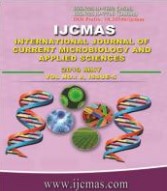


 National Academy of Agricultural Sciences (NAAS)
National Academy of Agricultural Sciences (NAAS)

|
PRINT ISSN : 2319-7692
Online ISSN : 2319-7706 Issues : 12 per year Publisher : Excellent Publishers Email : editorijcmas@gmail.com / submit@ijcmas.com Editor-in-chief: Dr.M.Prakash Index Copernicus ICV 2018: 95.39 NAAS RATING 2020: 5.38 |
Bakanae disease caused by Fusarium moniliformae Sheldon [Teleomorph- Gibberella fujikuroi] is a major rice disease in many rice growing countries including India. It is emerging as major problem of basmati rice in basmati producing areas of India and causing serious losses in basmati rice production. The symptoms of bakanae disease appear at all stages of crop from nursery to the maturity. To know the occurrence of bakanae disease, a survey was conducted during September, 2015 in the five districts (Meerut, Hapur, Gaziabad, Baghpat and Shamli) of Western Uttar Pradesh. During survey, it was observed that commonly grown rice varieties by the farmers of these districts are PB-1121, PB-1509, PB-1, Sarbati, and Sughandha-5. Among these varieties most preferred basmati rice variety is PB-1121 which was growing in 92 fields of 130 rice fields followed by PB-1509. Out of these five varieties, maximum bakanae disease prevalence (100%) was observed in PB-1121 followed by 80% in PB-1509. The incidence of bakanae disease was observed in range of 3.4-7.8% in PB-1121 in all surveyed districts. Maximum disease incidence (7.8%) was observed in Baghpat district followed by Hapur (6.7%). In all five districts, over all maximum average disease incidence (5.32%) was observed in PB-1121.
 |
 |
 |
 |
 |